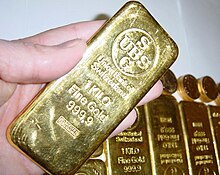Like other precious metals, gold is measured by troy weight and by grams. When it is alloyed with other metals the term carat or karat is used to indicate the purity of gold present, with 24 carats being pure gold and lower ratings proportionally less. The purity of a gold bar or coin can also be expressed as a decimal figure ranging from 0 to 1, known as the millesimal fineness, such as 0.995 being very pure.
The price of gold is determined through trading in the gold and derivatives markets, but a procedure known as the Gold Fixing in London, originating in September 1919, provides a daily benchmark price to the industry. The afternoon fixing was introduced in 1968 to provide a price when US markets are open.
Historically gold coinage was widely used as currency; when paper money was introduced, it typically was a receipt redeemable for gold coin or bullion. In a monetary system known as the gold standard, a certain weight of gold was given the name of a unit of currency. For a long period, the United States government set the value of the US dollar so that one troy ounce was equal to $20.67 ($664.56/kg), but in 1934 the dollar was devalued to $35.00 per troy ounce ($1125.27/kg). By 1961, it was becoming hard to maintain this price, and a pool of US and European banks agreed to manipulate the market to prevent further currency devaluation against increased gold demand.
On March 17, 1968, economic circumstances caused the collapse of the gold pool, and a two-tiered pricing scheme was established whereby gold was still used to settle international accounts at the old $35.00 per troy ounce ($1.13/g) but the price of gold on the private market was allowed to fluctuate; this two-tiered pricing system was abandoned in 1975 when the price of gold was left to find its free-market level. Central banks still hold historical gold reserves as astore of value although the level has generally been declining. The largest gold depository in the world is that of the U.S. Federal Reserve Bank in New York, which holds about 3%[72] of the gold ever mined, as does the similarly laden U.S. Bullion Depository at Fort Knox. In 2005 the World Gold Council estimated total global gold supply to be 3,859 tonnes and demand to be 3,754 tonnes, giving a surplus of 105 tonnes.[73]
Since 1968 the price of gold has ranged widely, from a high of $850/oz ($27,300/kg) on January 21, 1980, to a low of $252.90/oz ($8,131/kg) on June 21, 1999 (London Gold Fixing).[74] The period from 1999 to 2001 marked the "Brown Bottom" after a 20-year bear market.[75] Prices increased rapidly from 1991, but the 1980 high was not exceeded until January 3, 2008 when a new maximum of $865.35 per troy ounce was set.[76] Another record price was set on March 17, 2008 at $1023.50/oz ($32,900/kg).[76] In late 2009, gold markets experienced renewed momentum upwards due to increased demand and a weakening US dollar. On December 2, 2009, Gold passed the important barrier of US$1200 per ounce to close at $1215.[77] Gold further rallied hitting new highs in May 2010 after the European Union debt crisis prompted further purchase of gold as a safe asset.[78][79] On March 1, 2011, gold hit a new all-time high of $1432.57, based on investor concerns regarding ongoing unrest in North Africa as well as in the Middle East.[80]
Since April 2001 the gold price has more than quintupled in value against the US dollar, hitting a new all-time high of $1507.70[81], prompting speculation that this long secular bear market has ended and a bull market has returned.[82]
Taken From
http://en.wikipedia.org/wiki/Gold#HistoryYou can Sell Your Gold Now Click Here

No comments:
Post a Comment